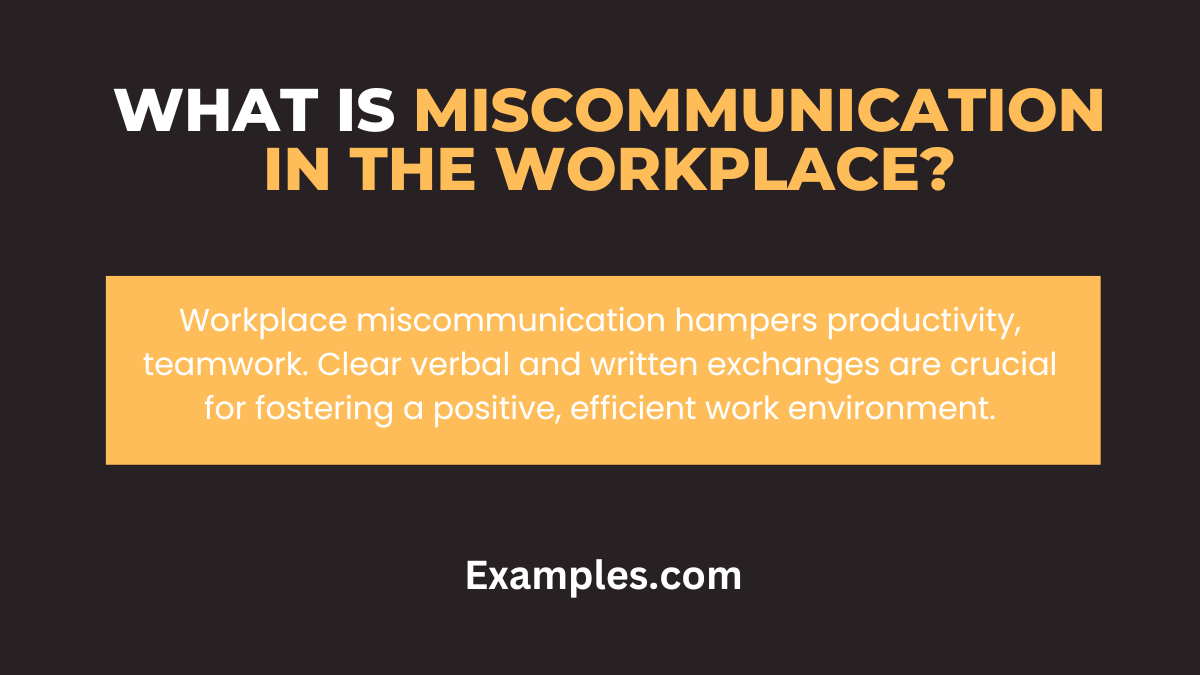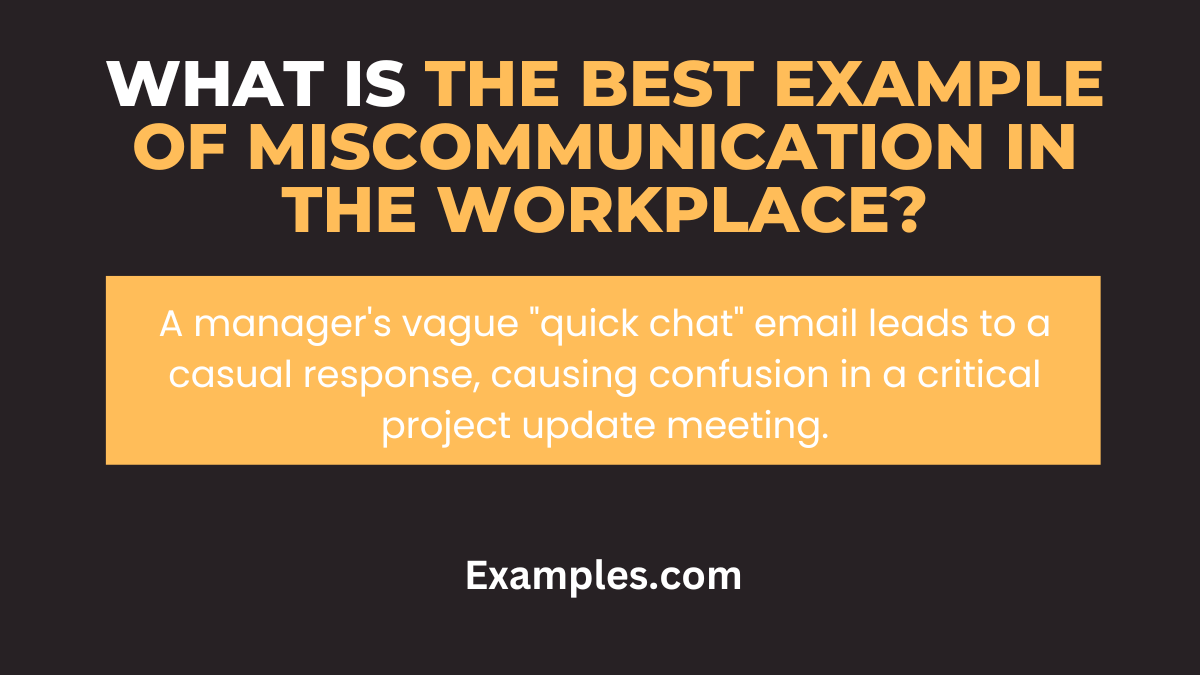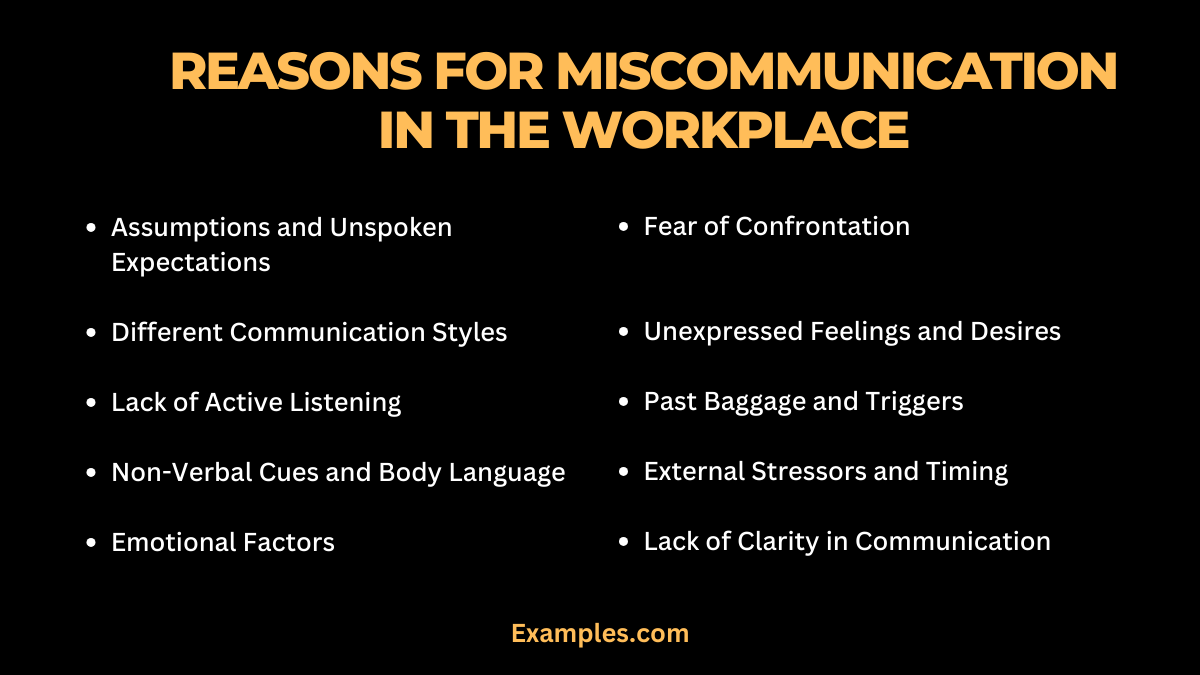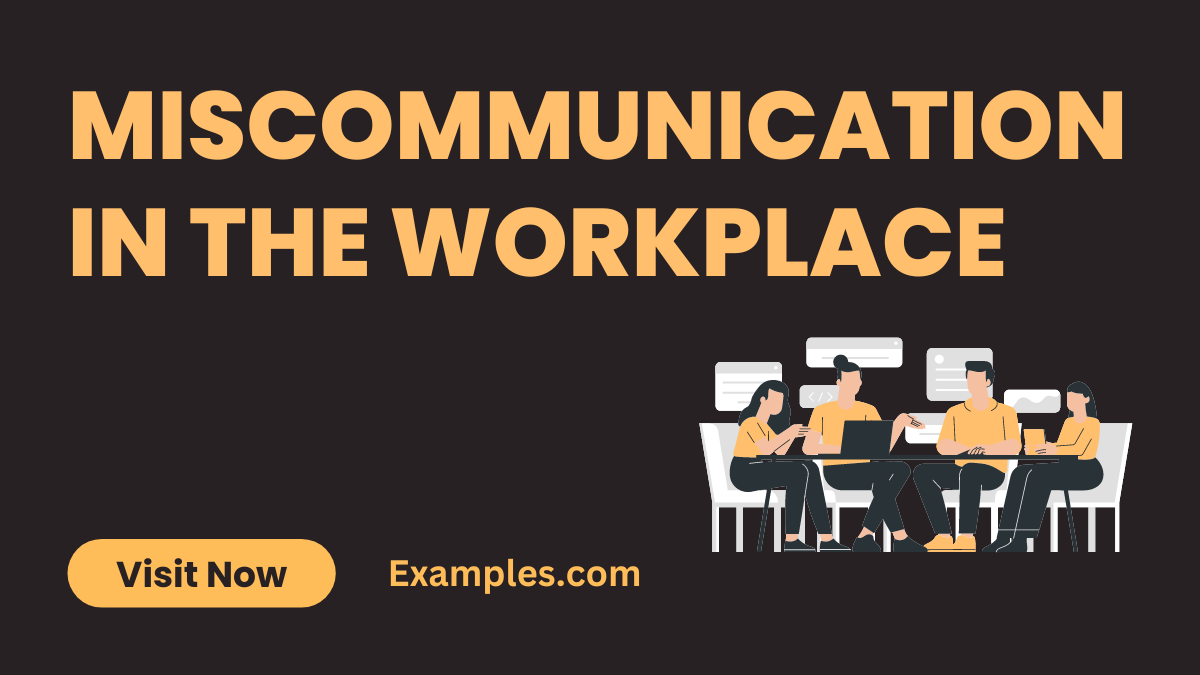Miscommunication in the Workplace
Embark on a comprehensive journey through our guide on workplace miscommunication, enriched with real-world examples that illuminate the nuances of effective communication. Uncover the intricacies of workplace dynamics, understand the impact of miscommunication, and gain actionable insights to navigate and improve professional interactions. This guide is your roadmap to fostering clearer communication, bolstering team cohesion, and ensuring a harmonious work environment. Explore now for invaluable communication examples and transformative tips.
What is Miscommunication in the Workplace? – Definition

Miscommunication in the workplace refers to instances where information is not conveyed accurately or clearly, leading to misunderstandings among team members. It encompasses verbal and written exchanges, including emails and messages, that may be interpreted differently than intended. Such breakdowns can hinder productivity, teamwork, and overall organizational effectiveness. Recognizing and addressing miscommunication is crucial for fostering a positive and efficient work environment.
What is the best Example of Miscommunication in the Workplace?

In this scenario, a manager sends a brief email to a team member requesting a “quick chat” without providing context. The team member interprets it as a minor issue and responds casually. However, the manager intended to discuss a critical project update. This misalignment in perception results in confusion during the meeting, causing frustration and impacting the project’s progress. This example underscores the importance of clear communication, setting expectations, and avoiding assumptions to prevent workplace miscommunication.
30 Miscommunication in the Workplace Examples
Explore 30 instances of miscommunication in the workplace in this insightful guide. Uncover real-life scenarios illustrating common pitfalls and challenges in professional communication. Gain valuable insights and practical solutions to enhance workplace dynamics, foster clear communication, and optimize team collaboration.
- The Email Ambiguity:
- Issue: Unclear email instructions lead to misunderstandings.
- Solution: Clearly outline expectations and key details in emails.
- Missed Meeting Details:
- Issue: Incomplete meeting invitations result in absent attendees.
- Solution: Provide comprehensive meeting agendas and details.
- Conflicting Project Priorities:
- Issue: Misalignment on project priorities causes confusion.
- Solution: Regularly communicate and align on project goals.
- Misinterpreted Feedback:
- Issue: Employee misinterprets feedback, affecting performance.
- Solution: Provide specific and constructive feedback.
- Unclear Task Delegation:
- Issue: Ambiguous task delegation leads to delays.
- Solution: Clearly communicate expectations and deadlines.
- Ambiguous Deadline Communication:
- Issue: Miscommunication on project deadlines.
- Solution: Clearly communicate and confirm deadlines.
- Vague Project Scope:
- Issue: Lack of clarity in project scope leads to errors.
- Solution: Clearly define project scope and deliverables.
- Incomplete Handover Information:
- Issue: Inadequate handover causes disruption.
- Solution: Provide comprehensive handover details.
- Misunderstood Office Policies:
- Issue: Misinterpretation of company policies.
- Solution: Conduct regular policy reviews and clarifications.
- Mixed Signals on Team Goals:
- Issue: Team members interpret goals differently.
- Solution: Clearly communicate and align on team objectives.
- Cross-Departmental Communication Gap:
- Issue: Lack of communication between departments.
- Solution: Implement regular cross-departmental meetings.
- Inconsistent Project Updates:
- Issue: Team members receive inconsistent project updates.
- Solution: Establish a centralized communication platform.
- Unclear Reporting Structure:
- Issue: Ambiguity in reporting lines causes confusion.
- Solution: Clearly define reporting structures and hierarchies.
- Miscommunication in Remote Teams:
- Issue: Remote teams face challenges in communication.
- Solution: Utilize effective communication tools and regular check-ins.
- Language Barrier Impact:
- Issue: Language differences lead to misunderstandings.
- Solution: Provide language training and encourage clarification.
- Meeting Agenda Misalignment:
- Issue: Misalignment in meeting agendas causes inefficiency.
- Solution: Distribute clear meeting agendas in advance.
- Ineffective Team Collaboration:
- Issue: Lack of communication hinders team collaboration.
- Solution: Foster a culture of open communication and collaboration.
- Unclear Performance Metrics:
- Issue: Ambiguity in performance metrics affects motivation.
- Solution: Clearly communicate performance expectations.
- Misunderstood Company Culture:
- Issue: Employees interpret company culture differently.
- Solution: Clearly define and communicate company values.
- Client Miscommunication:
- Issue: Miscommunication with clients impacts relationships.
- Solution: Establish clear communication channels and expectations.
- Technology Communication Gaps:
- Issue: Misunderstandings due to technology challenges.
- Solution: Provide training and support for technology tools.
- Feedback Implementation Lag:
- Issue: Delay in implementing feedback leads to frustration.
- Solution: Establish a feedback loop with prompt action.
- Project Goal Misalignment:
- Issue: Team members have varying project goals.
- Solution: Regularly communicate and align on project objectives.
- Employee Recognition Ambiguity:
- Issue: Ambiguity in recognizing employee contributions.
- Solution: Establish clear criteria for employee recognition.
- Client Expectation Mismanagement:
- Issue: Mismanagement of client expectations.
- Solution: Set and communicate realistic client expectations.
- Inconsistent Team Updates:
- Issue: Team receives inconsistent project updates.
- Solution: Implement regular and consistent project reporting.
- Training Material Misinterpretation:
- Issue: Misinterpretation of training materials.
- Solution: Provide supplementary clarification sessions.
- Conflicting Office Schedules:
- Issue: Conflicts in office schedules lead to disruptions.
- Solution: Implement a centralized scheduling system.
- Unclear Job Role Boundaries:
- Issue: Ambiguity in job role boundaries causes overlap.
- Solution: Clearly define and communicate job roles.
- Budget Miscommunication:
- Issue: Miscommunication regarding budget allocations.
- Solution: Establish clear communication channels for budget discussions.
What is a real life example of miscommunication in the workplace?

In the complex web of workplace dynamics, miscommunication can manifest in unexpected ways. Consider a scenario where a manager hastily conveys project updates through a brief email. Some team members, interpreting the brevity as a sign of minimal changes, proceed with existing plans. However, the manager intended to emphasize critical alterations, leading to a disconnect in project execution.
Key Points:
- Email Ambiguity:
- Manager communicates project updates briefly via email.
- Team members interpret the brevity differently.
- Divergent Perceptions:
- Some assume minimal changes; others grasp critical alterations.
- Varied interpretations lead to misalignment in project execution.
- Impact on Project Progress:
- The miscommunication results in confusion.
- Delays and inefficiencies arise due to conflicting actions.
- Lesson Learned:
- Clear and explicit communication is crucial in conveying the urgency and importance of updates.
- Misunderstandings can significantly impact project timelines and outcomes.
Navigating the Maze: Resolving Workplace Miscommunication
Miscommunication, once identified, requires strategic resolution. The following points outline practical ways to address and prevent miscommunication issues in the workplace.
Key Strategies:
- Establish Clear Communication Channels:
- Define primary channels for different types of communication.
- Ensure everyone is aware of and comfortable using these channels.
- Foster a Culture of Open Communication:
- Create an environment where team members feel encouraged to seek clarification.
- Promote the value of open dialogue and transparent communication.
- Active Listening Training:
- Provide training sessions on active listening skills.
- Encourage employees to paraphrase and confirm understanding during conversations.
- Written Communication Guidelines:
- Establish guidelines for effective written communication.
- Emphasize clarity, completeness, and the avoidance of ambiguous language.
- Feedback Mechanisms:
- Implement regular feedback mechanisms to assess communication effectiveness.
- Act on feedback to continuously improve communication processes.
- Training Programs:
- Conduct training programs on communication, including cultural sensitivity and language differences.
- Equip employees with tools to navigate diverse communication styles.
- Document Key Decisions:
- Keep detailed records of important decisions and discussions.
- Provide a reliable reference point to avoid misunderstandings.
- Encourage Face-to-Face Communication:
- Emphasize the importance of face-to-face communication for complex or sensitive matters.
- Physical presence reduces the risk of misinterpretation.
- Role Clarification:
- Clearly define and communicate roles and responsibilities within the team.
- Establish reporting structures to prevent confusion.
- Use Visual Aids:
- Supplement verbal and written communication with visual aids.
- Visual representations enhance understanding and minimize ambiguity.
- Timely Intervention:
- Address miscommunication promptly to prevent escalation.
- Swift intervention helps in resolving issues before they impact productivity.
- Cultural Sensitivity:
- Offer training on cultural sensitivity to promote understanding.
- Address potential cultural nuances in communication to foster incivility.
- Promote Accountability:
- Encourage individual and team accountability for effective communication.
- Establish consequences for consistent lapses in communication.
- Continuous Improvement:
- Regularly review and revise communication processes based on feedback and evolving organizational needs.
- Cultivate a culture of continuous improvement in communication strategies.
- Technology Utilization:
- Leverage technology tools that facilitate clear communication.
- Ensure employees are proficient in using these tools for efficient communication.
By integrating these strategies into the workplace culture, organizations can mitigate the risks of miscommunication, fostering an environment where clear and effective communication prevails.
Reasons for Miscommunication in the Workplace

- Assumptions and Unspoken Expectations:Employees may assume others share their knowledge or expectations, leading to misunderstandings.
- Different Communication Styles:Varied communication styles among team members can result in misinterpretation of messages.
- Lack of Active Listening:Inattentiveness during conversations leads to misunderstandings and missed information.
- Non-Verbal Cues and Body Language:Misinterpretation of non-verbal cues, such as facial expressions, impacts message understanding.
- Emotional Factors:Emotional states influence how messages are perceived, leading to misunderstandings.
- Fear of Confrontation:Employees may avoid difficult conversations, causing critical information to remain unaddressed.
- Unexpressed Feelings and Desires:Failure to express feelings or desires openly results in unmet expectations and miscommunications.
- Past Baggage and Triggers:Previous unresolved conflicts or personal issues influence message interpretation.
- External Stressors and Timing:High-stress situations or poor timing for discussions impact communication clarity.
- Lack of Clarity in Communication:Using vague or unclear language leads to misunderstandings about roles, tasks, or expectations.
How to Handle Miscommunication in the Workplace
- Identify the Issue:Pinpoint the source of miscommunication by clarifying information with all involved parties.
- Act Quickly:Address miscommunication promptly to prevent escalation and further misunderstandings.
- Encourage Open Communication:Create a culture where employees feel comfortable expressing concerns and seeking clarification.
- Active Listening:Ensure all parties actively listen to one another, encouraging paraphrasing to confirm understanding.
- Provide Clarification:If miscommunication stems from unclear instructions, provide additional clarification.
- Use Written Communication Wisely:For important information, consider using written communication for clarity.
- Implement Feedback Mechanisms:Establish regular feedback mechanisms to gather insights on communication processes.
- Training and Development:Provide training on effective communication skills, including active listening and clear expression.
- Facilitate Team Discussions:Organize team discussions to address miscommunication issues collectively.
- Clarify Roles and Responsibilities:Clearly define and communicate roles and responsibilities within the team.
- Utilize Technology Wisely:Leverage technology tools that facilitate clear communication.
- Encourage Face-to-Face Communication:When possible, encourage face-to-face communication to enhance clarity.
- Seek External Input:In complex situations, consider seeking input from external sources, such as consultants or mediators.
- Review and Revise Processes:Regularly review communication processes and revise them based on feedback and changing organizational needs.
How to Avoid Miscommunication in the Workplace
- Establish Clear Communication Channels:Define primary channels for different types of communication.
- Clarify Expectations:Clearly communicate expectations regarding tasks, projects, and deadlines.
- Encourage Active Listening:Train employees to actively listen and seek clarification when necessary.
- Written Communication Guidelines:Establish guidelines for effective written communication.
- Implement Feedback Loops:Establish regular feedback mechanisms to assess the effectiveness of communication processes.
- Training Programs:Conduct training programs on communication, including cultural sensitivity and language differences.
- Document Key Decisions:Keep detailed records of important decisions and discussions.
- Encourage Face-to-Face Communication:Emphasize the importance of face-to-face communication for complex or sensitive matters.
- Role Clarification:Clearly define and communicate roles and responsibilities within the team.
- Use Visual Aids:Supplement verbal and written communication with visual aids.
- Timely Intervention:Address miscommunication promptly to prevent escalation.
- Cultural Sensitivity:Offer training on cultural sensitivity to promote understanding.
- Promote Accountability:Encourage individual and team accountability for effective communication.
- Continuous Improvement:Regularly review and revise communication processes based on feedback and evolving organizational needs.
- Technology Utilization:Leverage technology tools that facilitate clear communication.
By addressing the root causes of miscommunication, promptly handling issues as they arise, and implementing preventive measures, organizations can foster a workplace environment where effective communication is the norm.



